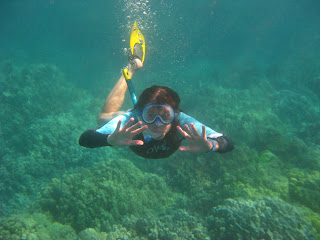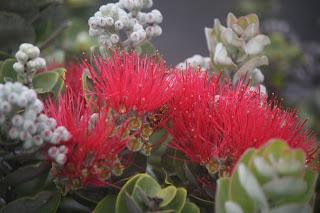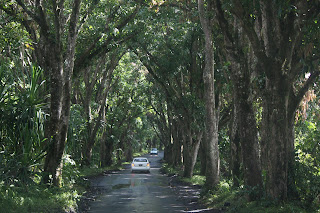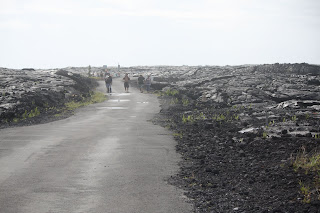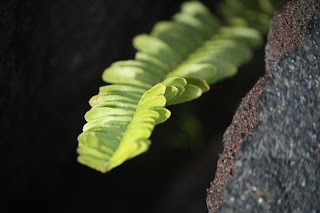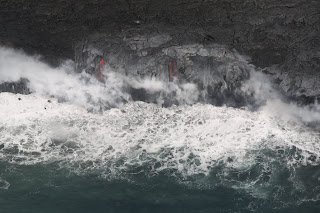Part 2(
View Part I—Overview)
Hawaii’s Big Island is the largest of the Hawaiian Islands, and it is still growing. Recent volcanic activity has added landmass to the island. The Big Island is also the youngest island. It consists of five shield volcano peaks, with two, Mauna Kea and Mauna Loa, reaching over 13,000 feet. Kilauea in the southeast part of the island is very active, with current eruptions occurring continuously since 1985.
We arrive late in Kona from the mainland, rent our car, and check into the King Kamehameha Hotel in Kailua. (Kona is the name of the airport, Kailua is the name of the town, and Kailua-Kona is the name the post office uses. Confusing, but basically Kailua and Kona refer to the same town.) The hotel is well located right at the Kailua Pier where the famous Ironman Triathlon begins, but we don’t particularly like the hotel. It’s big, impersonal, and a bit old. However, our room is comfortable, recently refurbished, and we have a partial view of the bay. We walk to downtown Kailua and pick a nice café for breakfast overlooking the bay. We notice a cruise ship outside the harbor, and soon, small tether boats begin depositing scores of cruise ship people in Kailua. We decide to hit the road. Before leaving, we briefly tour ‘Ahu’ena Heiau, the personal temple of King Kamehameha the Great. He lived here for the last seven or so years of his life.

We drive north to Highway 190 towards Waimea (called Kamuela by the postal service to distinguish it from Oahu’s Waimea). Waimea is a bustling town that sits in the valley between the extinct Kohala and Mauna Kea volcanoes. We pick out a likely place to have lunch—Merriman’s. Paul has a great nose for finding excellent places to eat and we are not disappointed. We also find a Foodland and purchase future lunch supplies and a cheap Styrofoam cooler.
Tip: Be sure to sign up for their discount card. We saved over $60 on our purchases. You just need to give them a phone number and spout the number in any other Foodland.
Great decision! We made our lunches for the next week, saving time and money. My Swiss Army knife came in very, very handy.
We continue winding our way to the small village of Honoka’a, where we secured a cute little house for two nights: Hale Hamakua Guesthouse. This house has a wonderful ocean view from the backyard, full kitchen, living room, three bedrooms, and bath. It is a block from the town and the town’s only real restaurant, Café Il Mondo, a pizzeria that makes excellent thin-crust pizzas. You bring your own wine.
Why stay in Honoka’a for two nights? Honoka’a is a mere 7 miles from alluring Waipi’o Valley where we planned an early morning horseback ride in the valley, followed by an afternoon hike. Staying in Honoka’a enables us to avoid the long drive from either the Kohala resorts, Kona, or the Hilo area.
Waipi’o Valley

We signed up with Na’alapa Stables for their horseback riding tour. The scariest part of the entire trek is the ride in their 4-wheel drive van down the 25% grade road. As we clambered into the van, our driver told us:
leave the sliding door open and don't use the seatbelts
I, however, dutifully fastened my seatbelt. He promptly told me to unfasten it. I exclaimed, ‘I thought you were kidding’. Apparently, no. If the breaks or transmission fails, your only hope of survival is to jump out of the van. I realized that there was no way all 9 of us could possible exit that van before the van began its descent to the valley floor—the short way.

Thankfully, we successfully made the trip to the valley floor, forded a few streams, and arrived at the stables. We were assigned mounts, took sips of water, tied our rain gear onto the saddles, clutched our cameras, and began our tour. We passed taro farms, forded streams, and saw waterfalls. Waipi’o Valley is truly a sacred, magical place.
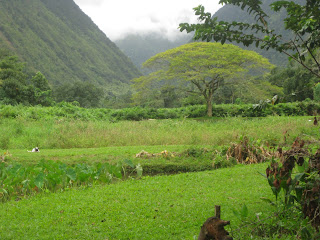
A few hours later, we finished our ride (it was a walk, really). We declined the return ride to the top of the valley so that we could commence with the second part of our Waipi’o adventure—hiking the switchback on the far side of the valley. We brought daypacks with water and lunch and headed to the valley’s black sand beach to reach the trailhead.
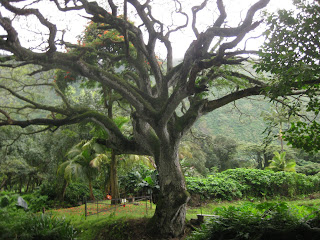
We walk to the beach and find a sheltered place for lunch. The beach is quite windy and the surf looks rough. After lunch we remove our hiking boots to ford the Waipi’o River. It’s moving pretty fast. We enter a place near the mouth, but a bit back from the raging surf. The water reaches past our knees and I grab Paul’s hand to make sure I don’t fall. I’m worried about my camera and my new zoom lens. Once successfully across, we make our way to the far side of the valley and find the trailhead to the next valley, Waimanu Valley. We hike to the top of the third switchback and have an amazing view of the coastline, the valley, the hazardous road into the valley, and the back of the valley. The sun has come out and we just take it all in.
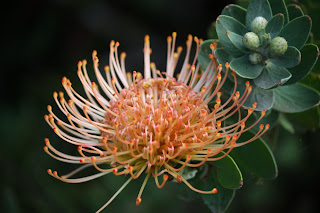
The return hike is uneventful, with fording the river the most challenging part. And, we must hike up that 25% grade road. It’s like being at the gym, doing a workout. But we feel good (and tired) when we’ve arrived.

Back in Honoka’a, we decide to check out the town’s only bar, the Hamakua Sports Bar. We were really hoping for a cold brew and a hamburger. We get the cold brew, but the only food consists of hot dogs, wings, chips and salsa, and popcorn. We went for the hot dogs because we were too tired to cook! The beer was good, the bartender was great, and we even met the owner. Honoka’a people are very friendly! And yes, they even have several TVs for sporting events.
Next: Helicopter Ride


